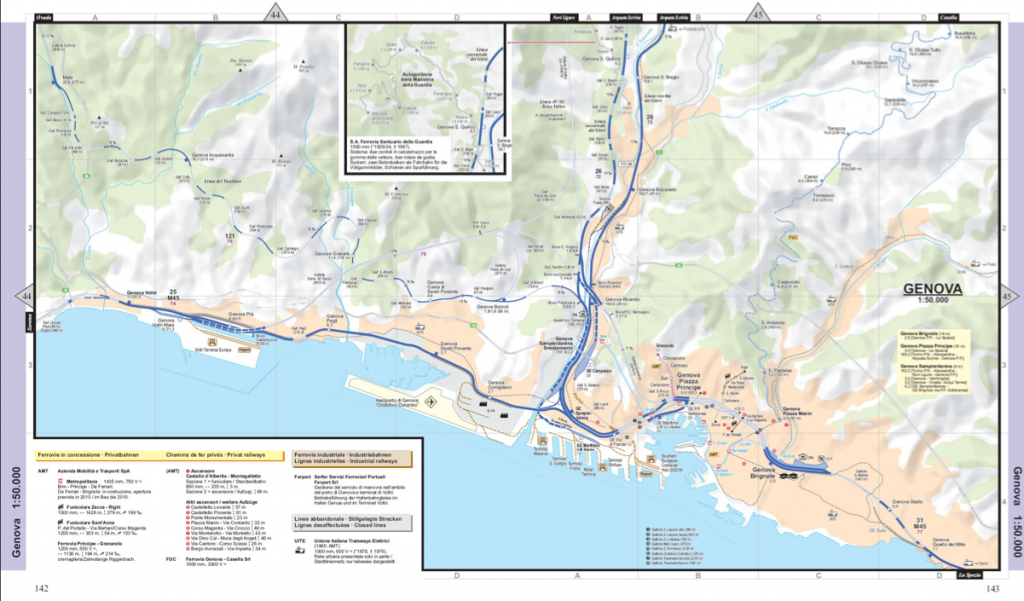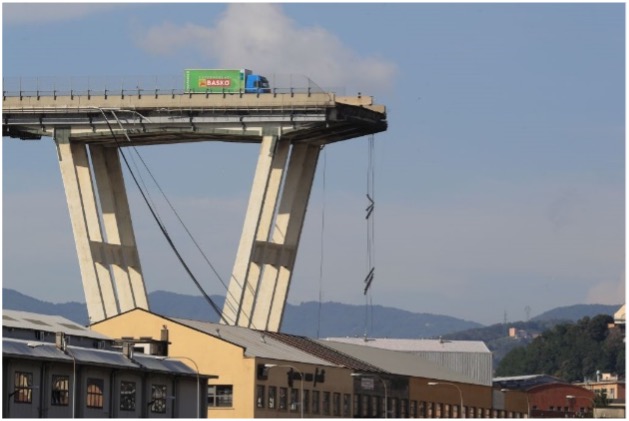On 14 August 2018, the Polcevera viaduct in Genoa (“Genova” in Italian) collapsed during a storm, leaving 43 people dead and many more injured. The bridge connected the motorways to Milan and to Marseille and, at least equally important, links the eastern and the western part of the city. Below the bridge are streets and railway lines, among them the most important rail link to Genova port.
As a result of the collapse, all car and truck traffic either has to run through the inner city of Genova or do rather long detours. Many suburban rail links are interrupted upon further notice, forcing longer travel times and route changes upon commuters, including the use of bus services through a congested road network. Parts of the port, the largest of Italy, are not accessible by rail, heavily disrupting a number of container and bulk services.
Bad as the situation is for the people of Genova and for local as well as regional transport, the main problems are just regional, explains Walter Finkbohner, a senior traffic and transport expert consulting both from Zürich and from Genova.
Alberto Milotti supports this view. He is director of Zailog, the research institute of the large freight village (“interporto” in Italian) of Verona Quadrante. ZAILOG is member of Open ENLoCC, the European Network of Logistics Competence Centers. Milotti says: “During the first weeks, the situation was somewhat less severe because of the school holidays.

But now that school has begun, it will get worse. Also, many people now must make detours on their way to work, have to change trains or use buses instead, on the network that already faces a situation of overload.”
The long distance transport chains are affected, but can find alternatives, both specialists confirm: The ports of La Spezia and Livorno are nearby. The Adriatic ports as well as the North Sea ports also are ready to serve as interfaces for some of the long distance freight. Therefore, most of the consequences are regional.
This clearly is different from the last major infrastructure disruption, the Rastatt accident on the railway line along the upper Rhine in Germany last autumn. There, it was the other way round. While significant commuter traffic was indeed affected, the main impact had been a disruption of long distance freight traffic flows, which was very difficult to reroute.
- Which solutions can be found?
Of course, there is no way around building a new bridge in the same location. As a short term solution, a truck road via an unused industrial area within the port can connect the eastern and western parts.
“It will also be an opportunity to improve public transport”, says Walter Finkbohner. “There is much that should be done anyway, and now the time has come.”
“For rail transport, an intermediate solution could be a hinterland terminal as an interface”, adds Milotti. “Trains would operate from there, and only the last 50 km or so, containers would have to be trucked.”
- What has caused the bridge to collapse?
Apparently, the cables of the suspension bridge were heavily corroded. The Genova bridge was designed half a century ago specifically to avoid corrosion, according to the standards of that time. Back then it was thought that covering steel cables in concrete would avoid the corrosion problem. To cover the cables, they were bundled. The result looks very elegant, but resulted in lack of redundancy. This makes maintenance a big problem.
Autostrada, the operator of the bridge, was generally aware of the problems. Only in spring had they asked for a check of the bridge’s stability. The result had been alarming, and by the time of the collapse a larger overhaul was in the process of being tendered. However, Autostrada did not publicly consider closing the bridge
Relatively little reseach has been done on infrastructure maintenance, finds Walter Finkbohner. “This is a general problem. Here in Genova, there also is the proximity of the sea, with high humidity and varying temperatures. That may be an additional factor just for this bridge, given its style of construction.”
Another factor may be the sheer volume of today’s traffic. When the bridge was built, the number of heavy trucks was much lower than what it is today. Furthermore, there is the question of the weight limit. “That is not much a question for the logistics industry”, says Alberto Milotti. “The logisticians know the weight of their loads, for example of the containers.” And most of its cargo is relatively lightweight anyway. But what about, for example, the trucks that carry excavated earth from construction sites? They tend to be loaded up to the weight limit, to say the very least.
There are a few points to learn from the tragedy:
- The infrastructures of the industrial age are ageing all across Europe. Bridges may be the most vulnerable part. There probably are thousands of bridges that need attention. Some designs stand the test of time better than others. But whatever, logically there must always be one design that fails first, and this does not mean that all other designs are much safer.
- We learned the hard way that some of the infrastructure already is no longer safe. Before the collapse, any person or institution that would have demanded a closure of the bridge would have been made responsible for the resulting traffic breakdown in Genova, which would have ended political and management careers. Now we know that such warnings may be well founded.
- We also learned that our infrastructure is not very redundant. Actually, the less redundant a new infrastructure is going to be, the more easily it gets funded, since as such it results in the highest productivity gains. We may have to have a second look at this principle and need to put more emphasis on establishing potential alternatives.
On the other hand, there is the pragmatism of the key players in a major port. If necessary, much can suddenly be achieved at short notice. There even is a surprising prospect: “The construction of a modern suspension bridge can be done within six months”, says Alberto Milotti. “Add the time for planning and tendering, and the total time may be a year and a half. Compare that to the usual decade long struggle for planning and financing a new motorway or railway line.”
“Miracles are possible in Italy”, adds Walter Finkbohner. “I would definitely not rule that out, if all partners are dedicated.” Walter Finkbohner helps organizing a public congress about the consequences of the bridge collapse, held by the City of Genova on 10 October.
Text: Martin Brandt
Breaking News, September 26: Eduardo Rixi, Member of Parliament for Genoa and since September 13 Italian Vice-Minister of Infrastructure and Transport, has announced the re-opening of the rail link to the port for October 4.
